Willy Wonka, Jr. On Stage at Edgewood Elementary School
- Details
- Written by: Joanne Wallenstein
- Hits: 4047
 The Oompa Loompas in Edgewood School's performance of Willy Wonka, Jr.After more than 30 years without a multi-grade level play, theater returned to Edgewood Elementary School’s main stage with KJK's production of Willy Wonka Jr, performed by 3rd, 4th and 5th grade students on Friday, January 17th.
The Oompa Loompas in Edgewood School's performance of Willy Wonka, Jr.After more than 30 years without a multi-grade level play, theater returned to Edgewood Elementary School’s main stage with KJK's production of Willy Wonka Jr, performed by 3rd, 4th and 5th grade students on Friday, January 17th.
The students worked hard for two weeks, rehearsing every day after school for 2 1/2 hours, which culminated in two performances - one for their teachers and peers, and an evening show for parents, family, and friends. Despite the grueling schedule and many of the cast members coming down sick - the show went on! The students were excited to see their work come to fruition and learned a lot about theater and performing for an audience.
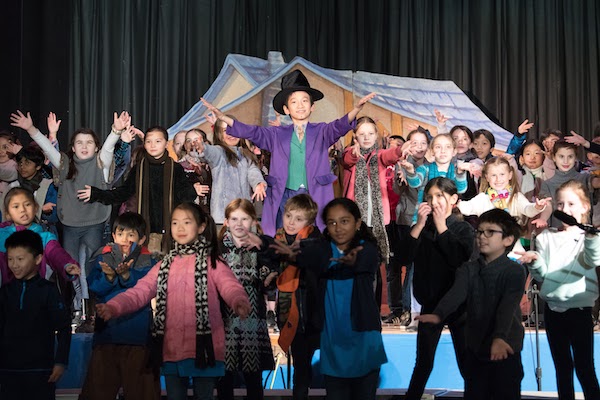 Edgewood students with 4th grader Ren Shirai as Willy Wonka.
Edgewood students with 4th grader Ren Shirai as Willy Wonka.
The show also benefitted from 7 students as stage crew members who learned about sound, lighting, and backstage work. In previous years, school-wide plays were thought to be too difficult because the gym can only accommodate a limited number of audience members. Yet this year, led by the vision of PTA members and collaborative efforts with school principal Tashia Brown and assistant principal William Yang, it was agreed that a production would work for the upper elementary students, with the idea that K-2 students can look forward to being in future productions. 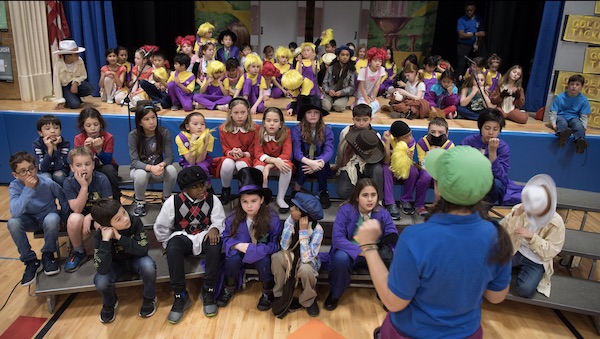 The cast of Edgewood's Willy Wonka Jr listening to director Suzie Hepker of KJK Productions
The cast of Edgewood's Willy Wonka Jr listening to director Suzie Hepker of KJK Productions
The school community was impressed by the performance and it is hoped that a school play will now become one of Edgewood's yearly traditions.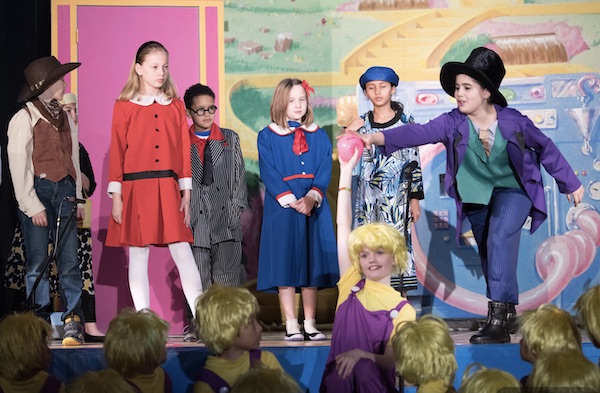 Edgewood students performing in Willy Wonka Jr
Edgewood students performing in Willy Wonka Jr
New Board Leadership for a New Year -- Plus Budget Numbers, Enrollment Projections and Proposed 20-21 Calendar
- Details
- Written by: Joanne Wallenstein
- Hits: 6766
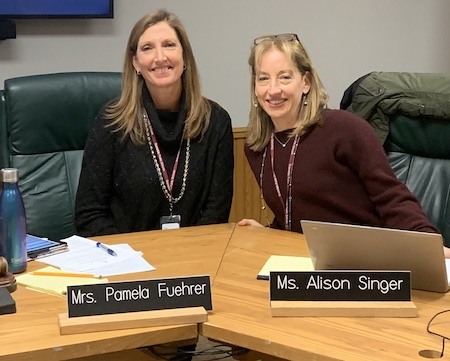 At the first meeting of the Board of Education on January 13, 2020, the Board elected new leadership. Customarily, Board Presidents and Vice Presidents are elected at the end of the school year in July. However last summer, when the Board did their transition planning they recognized that they had three new members starting their terms. As the Board was composed of many “young” members, the Board elected to extend the service of more seasoned members, with Scott Silberfein serving as president and Pam Fuehrer as vice president for an additional six months.
At the first meeting of the Board of Education on January 13, 2020, the Board elected new leadership. Customarily, Board Presidents and Vice Presidents are elected at the end of the school year in July. However last summer, when the Board did their transition planning they recognized that they had three new members starting their terms. As the Board was composed of many “young” members, the Board elected to extend the service of more seasoned members, with Scott Silberfein serving as president and Pam Fuehrer as vice president for an additional six months.
So, now that six months has passed, the Board voted to select Pam Fuehrer as President and Alison Singer as Vice President. They were both elected unanimously and sworn in by Dr. Hagerman.
Here are some highlights of the meeting:
2020-21 School Budget
Ass’t Superintendent Stuart Mattey opened the meeting with an overview of the proposed 2020-21 school budget. The early draft calls for a total budget of $167,078,421 which is a 3.92% budget to budget increase over 2019-20 and would mean a projected tax increase of 3.66%, or $268,118 above the projected tax levy limit.
Staffing and Special Education
In order to begin budgeting for the 2020-21 school year, the administration reviewed current district staffing as well as requests for additional school staff for next year.
This year’s staffing is pretty much on target with the staffing specified in the actual 2019-20 budget. Due to the need for an additional kindergarten section, the budgeted contingency position was used, and staffing is just .7 employees above budget.
Due to increases in the number of students in special education which has grown by 150 students over the past five years, Director of Special Education and Student Services Eric Rauschenbach explained a request for an additional special education co-teacher as special education sections may grow from 13 to 14 classrooms.
He is also proposing that some students who are currently placed out of the district be brought back to the district with the formation of a special class for K-2 students, called 8:1:2. This refers to 8 students, 1 teacher and 2 aides. Rauschenbach said that forming this class would be budget neutral as some of the students who would be served in this class are currently attending out-of-district schools at a cost of $65,000 a year. If there is capacity, students from other districts could pay tuition to attend. He explained, “10% of students are special needs – up from 7% four to five years ago. We are being forward in trying to bring kids back into the district.”
In a discussion of the proposal, Board Member Alison Singer said, “This will enable more students who live in the district to benefit from a Scarsdale education.”
Rauschenbach also made a request for a part-time secretary for the school psychologist at the middle school. The staffer would do clerical work, schedule appointments, track students and greet people in the office when the psychologist is behind closed doors.
Discussing overall staffing for 2020-21, Drew Patrick said the budget will include funding for one additional special education class, one less elementary school section and a contingency position for higher than expected student enrollment.
2020-21 School Calendar
Dr. Hagerman provided a preview of the tentative school calendar for the 2020-21  school year.
school year.
Here are the dates that he said are “likely” but necessarily set:
First day of school: September 8, 2020
Christmas Break: December 23, 2020 – January 4, 2021
February Break: February 15-19, 2021
Spring Break:
March 29 –April 2, 2021
Or April 5 – 9. 2021
Last Day of School: June 25, 2021
Retirement
Assistant Superintendent Drew Patrick announced that SHS Social Studies teacher Maria Valentin would retire at the end of the school year after teaching here for 18 years.
Lights at Butler Field
Maroon and White President Kate Conlan and Steve Nicholas from the Light the Field committee proudly announced that the committee had met their goal and raised $800,000 for lights at Butler Field. Conlan said, “We are fully funded and ready to move forward,” Nicholas thanked the board and the 500 families who got involved. A group of supporters attended the meeting and cheered the news.
Director of Security Mike Spedaliere reported that the district is now in compliance with NYS guidelines for drills and has conducted the required lockdowns, fire evacuation drills and shelter in place drills. In order to improve communications inside the school buildings and between the school buildings, the district tested a portable radio system and was pleased with the transmission. The district plans to purchase new portable radios for all district schools using funds from the security and facilities budgets.
Enrollment Projections
Assistant Superintendent Drew Patrick reviewed demographic and enrollment projections for the next five years.
Despite a projection last year that enrollment would drop steeply, it turned out that enrollment has been very stable ranging from 4,721 to 4,821 students over the last ten years. With 4,745 students enrolled as of October 2019, the district is now in the lower portion of that range.
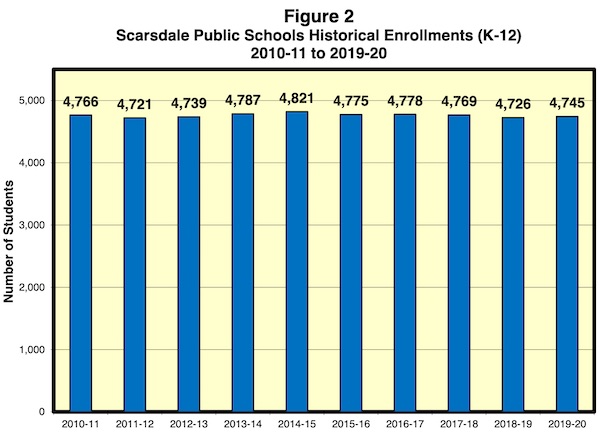
The demographer compared the number of students enrolling in kindergarten to the number of graduating seniors each year and found that the district’s “kindergarten replacement” numbers have been negative for eight out of the past nine years. However, he also found that this loss in enrollment is offset by the inward migration of students in later grades.

For instance, for the 2019-20 school year, the district’s kindergarten replacement number was negative 63 students however, overall district enrollment grew by ten students who came into the system in the older grades.
Looking ahead for the next five years, the demographer projects stable enrollment with a possible decline of 40 students over the five-year span. While elementary school enrollment is projected to dip slightly, the numbers in the middle school and high school will rise. It is interesting to note that enrollment at Greenacres School was 411 students in 2010-11 is now at 337 students and is projected to drop to 294 students by 2024-25. The school is currently being expanded.
High School Start Time
Should high school begin later to allow teens more time to sleep? The American Academy of Sleep Medicine recommends that that middle schools and high schools should start at 8:30 a.m. or later to support teen health, alertness and safety. But Scarsdale Middle School begins at 8:10 and Scarsdale High School at 8 am.
In order to begin discussions around a schedule change, the school administration did some research to assess other school’s schedules and gather input from superintendents around the state.
Dr. Hagerman’s query to superintendents only yielded three responses, one who said, “Unless the state or all component BOCES school districts (for 1 BOCES) agree to the time change the issue should be dropped. 1, 2 or 3 districts going alone on this will only cause more problems for the students that it is trying to help. The age-old adage is aptly applied here: If it isn’t broke, don't fix it.” Athletic Director Ray Pappalardi found that other athletic directors were against a schedule change, by a ratio of roughly 2:1.
A study of school start times found that Scarsdale’s 8 am start time was “in the middle of the pack.”
Questions to Assemblywoman Amy Paulin’s office found that there is no work around this issue going on at the state level.
Since a change in the start time could impact the time school ends along with the athletic schedule and the transportation plan for the entire district, the decision has far-reaching effects.
In a discussion about the issue that was held over from the December BOE meeting, Board member Carl Finger said, “There is variation in the start time of neighboring high schools, with some starting as late as 8:30. Some were ending at 3:15 or 3:20. If we did want to start later, how would that work? How good an idea do we think it is? I think it is a reasonable idea. How can we facilitate it? What would it entail? What does the community think? Maybe we can adjust our free periods?”
Dr. Hagerman said, “The research is unequivocal that there are benefits to more sleep. But we can’t assume that changing the schedule does not necessarily equate to more sleep.” Pam Fuehrer added “adolescent brains are programmed to operate best later in the morning.”
Discussing next steps, Dr. Hagerman said, “What problem are we trying to solve? I would want to speak to the faculty and students. Do they think they are not getting enough sleep? Have they thought about the trade-offs? There are many implications to consider. I think we have to ask the users of the experience how they are feeling about it. High School students might like to start at 9:30 but once they consider the other choices they might have a different answer.”
Drew Patrick said, “On the days school ends at 3:05 the athletes struggle to make the buses to athletic events.” At the conclusion of the conversation Dr. Hagerman agreed to speak to SHS Principal Ken Bonamo and then have a further discussion about next steps.
Girls Basketball Still Trying To Find Its Rhythm
- Details
- Written by: Ray Cooper
- Hits: 3597
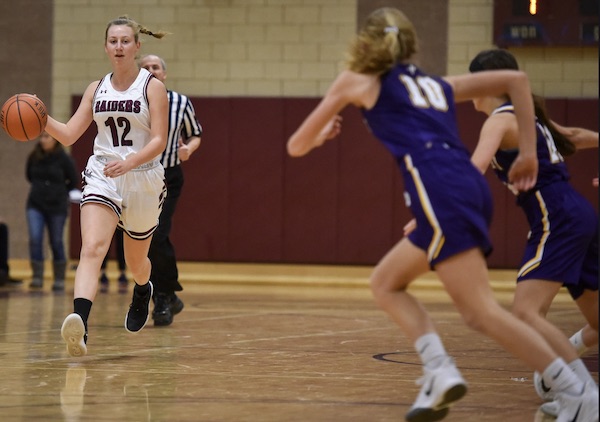 Kayla Maroney drives on John Jay.The Scarsdale girls’ basketball team hosted its first game of 2020 on Saturday January 3 against the highly touted Arlington Admirals. The Raiders were looking for their first win of the season, while the Admirals came into the event 3-1 with recent blowout wins against Fox Lane and Clarkstown North – and their only loss of the year against perennial powerhouse Ursuline.
Kayla Maroney drives on John Jay.The Scarsdale girls’ basketball team hosted its first game of 2020 on Saturday January 3 against the highly touted Arlington Admirals. The Raiders were looking for their first win of the season, while the Admirals came into the event 3-1 with recent blowout wins against Fox Lane and Clarkstown North – and their only loss of the year against perennial powerhouse Ursuline.
Prior to the game, a moment of silence was observed in memory of recently departed Scarsdale resident and former NBA Commissioner David Stern. Raiders’ co-captain Jessica Solodar was back in action as Scarsdale came out for the opening tip.
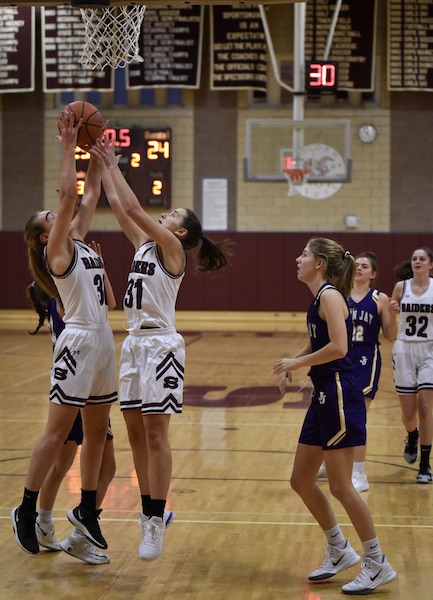 Meghan Quirk and Phoebe Shearer grab a rebound.The first quarter started fairly evenly as teams traded early baskets. Halfway through the quarter, Arlington star player and co-captain Molly Stephens went on a scoring spurt – hitting two three pointers and adding a few free throws in a short period of time. Scarsdale had trouble controlling the ball early and had multiple turnovers on each end of the court. Despite the five points contributed by senior co-captain Kayla Maroney, the quarter ended with the Raiders trailing 19-10.
Meghan Quirk and Phoebe Shearer grab a rebound.The first quarter started fairly evenly as teams traded early baskets. Halfway through the quarter, Arlington star player and co-captain Molly Stephens went on a scoring spurt – hitting two three pointers and adding a few free throws in a short period of time. Scarsdale had trouble controlling the ball early and had multiple turnovers on each end of the court. Despite the five points contributed by senior co-captain Kayla Maroney, the quarter ended with the Raiders trailing 19-10.
Scarsdale’s struggles continued in the second quarter as the Admirals continued a combination of strong defense and solid shooting. Point guard Mia Castillo added to her five first quarter points with eight more, including several bombs from outside. The Raiders began substituting liberally – trying to find the right combination. Maeve Jacobson provided much needed defensive help along with Moira Conlan and Isabelle Goldban. While the Admirals equaled their first quarter production, Scarsdale only added six points and the half ended with the Raiders trailing 38-16.
The second half saw the Raiders tighten its game considerably. While the offense still struggled to convert on opportunities, the defense clamped down and held the Admirals at bay. Co-captain Meghan Quirk hit a three pointer mid way through the third quarter and Maroney added eight points. The teams played quite evenly and the end of third quarter saw the Admirals lead stand at 24 points.
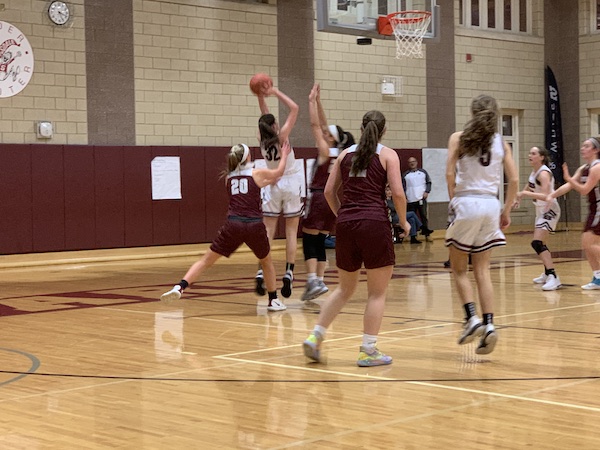 Moira Conlan about to score.
Moira Conlan about to score.
The final quarter saw the Raiders continue to improve. Goldban poured in 7 points while center Abby Talish found the mark and added four points. Maroney also added a three pointer late bringing her total to a Raider-game high 17 points, and Scarsdale outscored Arlington 16-14 in the fourth quarter. The Admirals’ Stephens and Castillo tallied 14 and 19 points respectively as Arlington prevailed 64-42.
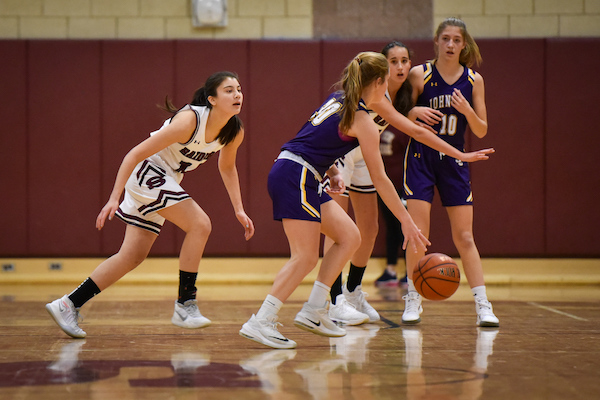 Raiders on the Defense
Raiders on the Defense
Scarsdale continues its campaign with two more tough opponents: On January 7th the lady Raiders travel to New Rochelle and the following week host Mt. Vernon. Photos by Jon Thaler. See more here.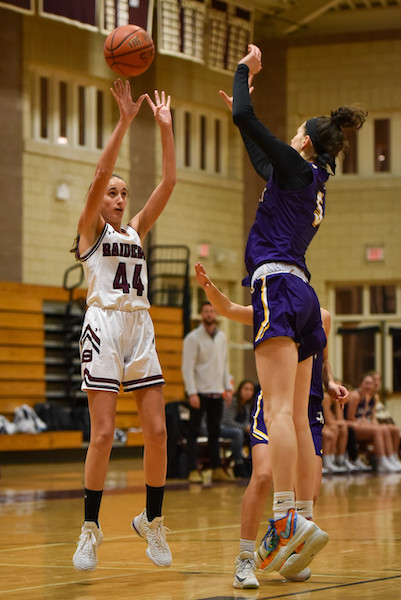 Abby Talish takes a jumper.
Abby Talish takes a jumper.
Sports News: Four Honored at Section 1 Football Awards Dinner, Hockey Team Donates Gifts for Kids
- Details
- Written by: Joanne Wallenstein
- Hits: 4323
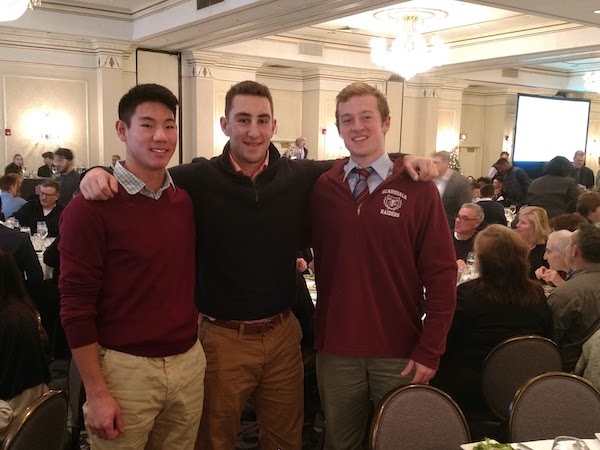 Four Scarsdale High School football’s players were feted at the 2019 New York State High School Section 1 Football awards dinner on Sunday December 15 at the Pearl River Hilton. The section includes 70 high schools. Scarsdale’s Sam Feldman, Dean Mancini, Chris Saenger, and Harry Song were given their awards as “all conference” or “all section” players. Sam Feldman was also awarded league player of the year as offensive lineman. The players were acknowledged as the leaders of a team that posted a great season record of 5 wins and 2 losses, with the losses against the two finalists in the state playoffs.
Four Scarsdale High School football’s players were feted at the 2019 New York State High School Section 1 Football awards dinner on Sunday December 15 at the Pearl River Hilton. The section includes 70 high schools. Scarsdale’s Sam Feldman, Dean Mancini, Chris Saenger, and Harry Song were given their awards as “all conference” or “all section” players. Sam Feldman was also awarded league player of the year as offensive lineman. The players were acknowledged as the leaders of a team that posted a great season record of 5 wins and 2 losses, with the losses against the two finalists in the state playoffs.
Pictured Above: Harry Song, Sam Feldman, Chris Saenger (not pictured: Dean Mancini)
Hockey Team Donates Gifts to Hospital
On December 14, the Scarsdale Varsity Ice Hockey team donated over $1,000 in gifts to the Maria Fareri children's hospital in Valhalla.
High School Physical Education teacher James Synowiez, who coaches the team, reported:
 "This season the Varsity Ice Hockey team was interested in donating or helping out a local charity. We decided that purchasing gifts to help make the holiday season brighter for children who are not able to be home with their families would be a great way to give back to the community. Each student-athlete was responsible for bringing at least one gift to the hospital on the donating day last Saturday morning, prior to our game. As a coach I was impressed with the selflessness our boys displayed and the amount of gifts that they showed up with. We look forward to making this an annual tradition!"
"This season the Varsity Ice Hockey team was interested in donating or helping out a local charity. We decided that purchasing gifts to help make the holiday season brighter for children who are not able to be home with their families would be a great way to give back to the community. Each student-athlete was responsible for bringing at least one gift to the hospital on the donating day last Saturday morning, prior to our game. As a coach I was impressed with the selflessness our boys displayed and the amount of gifts that they showed up with. We look forward to making this an annual tradition!"
One Thousand Acts of Kindness from Middle School Students
- Details
- Written by: Joanne Wallenstein
- Hits: 5770
 From left to right AJ Hart, Andrew Mandel, Rachel Rakower, Kate Hubell, Joyce Liu, Skylar Katz, Amanda Gorrin, Ellie Greenspan, Eli LeblangSixth graders from Butler House and Fountain House at Scarsdale Middle School have organized 1000 acts of kindness over the school year. The effort is led by social studies teachers, Ms. Jeanne-Marie Castiello (Butler House) and Adam Nichols (Fountain House).
From left to right AJ Hart, Andrew Mandel, Rachel Rakower, Kate Hubell, Joyce Liu, Skylar Katz, Amanda Gorrin, Ellie Greenspan, Eli LeblangSixth graders from Butler House and Fountain House at Scarsdale Middle School have organized 1000 acts of kindness over the school year. The effort is led by social studies teachers, Ms. Jeanne-Marie Castiello (Butler House) and Adam Nichols (Fountain House).
According to Ms. Castiello, here is what they did:
Butler 6 worked with Fountain 6, their sister house, to collect over 255 toys for the Children's Hospital at Montefiore (CHAM). For the last three years, students have donated toys to Montefiore's Annual Holiday toy drive. Next week the toys will be distributed to patients at the Children's Hospital Holiday Party.
Butler 6 collected educational baby and infant toys for the NICU at CHAM.
For the holiday season each of Ms. Castiello’s students wrote letters and cards for Thanksgiving and the holidays to senior residents at the Schaffer Extended Care Center at Montefiore. Students will continue to correspond with the senior residents for the entire school year.
Ms. Castielle said, “The generosity of spirit is truly heartwarming and amazing. To see sixth graders dedicated to helping others is awe inspiring and gives true meaning to the holiday season.”
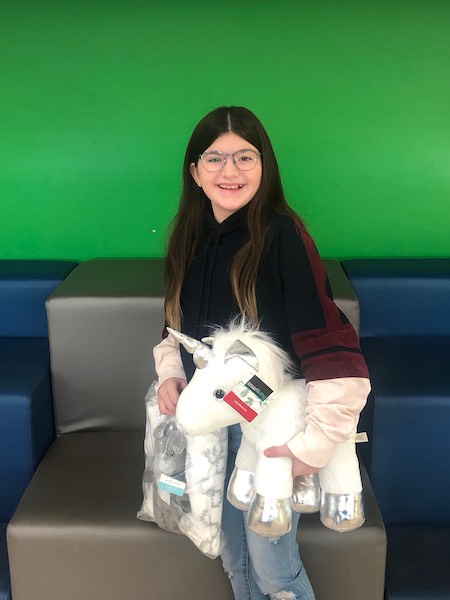 Alexandra Israel
Alexandra Israel Joey Pappalardo
Joey Pappalardo
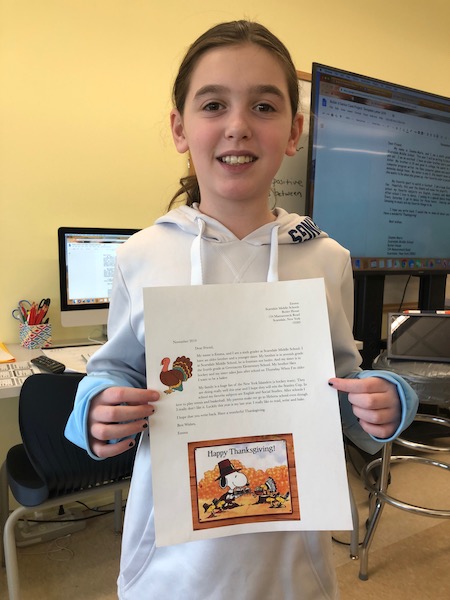 Emma Lerner
Emma Lerner
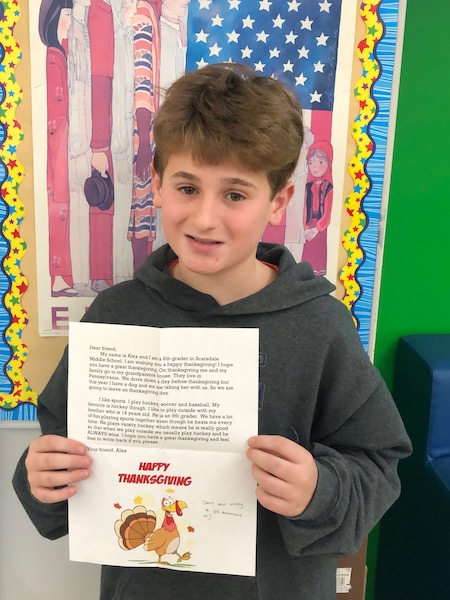 Alex Horner
Alex Horner










